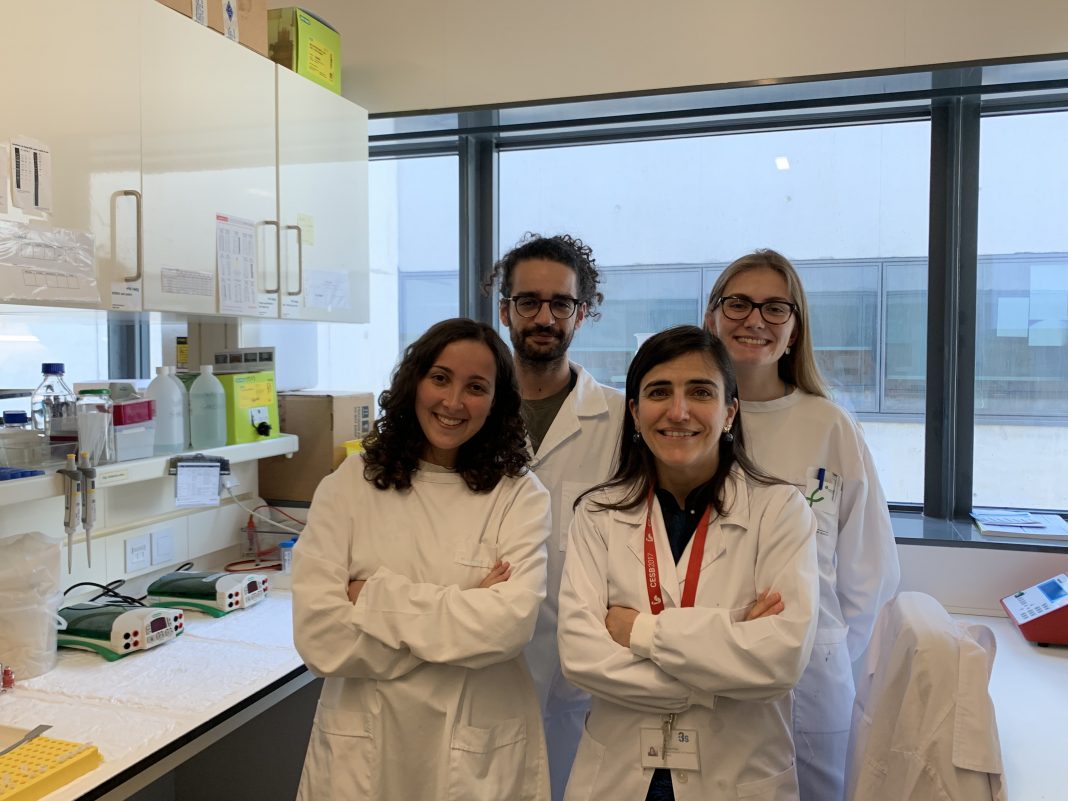
Photo Credit: MECHANO.
MECHANO is “proposing an in vitro model of the brain tissue” to explore the treatment of this demyelinating disease.
Funded by FCT, the Exploratory Research Projects (ERP) are short-term exploratory scientific projects proposed by teams of experts and researchers targeting strategic areas of the UT Austin Portugal Program. MECHANO is one of the 14 awarded projects, selected in 2018.
The research team has been working on a nanomaterial-based technology to understand how to go “From the mechanobiology of the glial to the management of multiple sclerosis”, as the title of the projects describes.
We talked to Principal Investigators Ana Pêgo, Assistant Researcher at INEB, and Laura Suggs, Biomedical Engineering Professor at The University of Austin at Texas (UT Austin), to learn more about how nanotechnology may contribute to the development of new therapeutic approaches to the treatment of Multiple Sclerosis.
The MECHANO exploratory research project proposes the usage of a nanomaterial-based technology to better understand the progress and properties of Multiple Sclerosis (MS). Can you provide some insight on how nanomaterials are expected to be used and what kind of new observations they will allow?
The loss of myelin sheath – an insulating membrane that wraps axons – is one of the major mechanisms responsible for the loss of function observed in many neurological diseases. Multiple sclerosis (MS) is the most frequently occurring demyelinating disease of the central nervous system (CNS) with over 3 million people affected worldwide. In the adult CNS the myelin sheath can be partially rescued by remyelination of spared axons. Oligodendrocyte precursor cells (OPCs) can differentiate and enwrap axons although at a lower extent. With disease progression, oligodendrocyte differentiation and remyelination is hampered leading to axonal degeneration and neuronal death. Our goal is to underpin the reasons underneath this change. There is growing evidence that matrix rigidity plays a key role in the process of OPC differentiation and oligodendrocyte myelination by unbalancing the intra/extracellular forces. To understand when/how the changes in a brain lesion biophysical environment occur and how these condition the progress of disease, in MECHANO we propose the use of a “tool box” by constructing a 3D tissue engineered model of a CNS scar exploring nanomaterials. The nanomaterials will be used to prepare different components of this platform (namely, cell culture substrates and extracellular matrix) and to allow the possibility to alter in real time and live the mechanical properties of the extracellular matrix.
What is the current percentage of patients diagnosed with MS in Portugal and in the US? Are the numbers increasing?
With over 700,000 affected patients in the EU and nearly a million living with MS in the US, multiple sclerosis (MS) represents the most frequently occurring demyelinating disease of the central nervous system. In Portugal the numbers of the Portuguese Society for MS point to 8,000 diagnosed cases. To the best of our knowledge there is no definitive evidence that the rate of MS is on the increase. However, you can find references indicating that the number of those diagnosed with MS today is higher than in the past. Most probably, due to a greater awareness of the disease, better access to medical care and improved diagnostic capabilities.
This project involves a transatlantic research team, from INEB and the University of Austin at Texas, as well as from Politécnico de Leiria and Nanohmics. Tell us more about the complementarity of skills, backgrounds and resources this project has assembled. What brought these institutions together?
To create a synthetic yet biologically meaningful tissue engineered astroglial scar and progress to the design of new therapeutic avenues to treat MS represents a significant biological and engineering challenge. So, we had to combine the complementary expertise of the teams that take part in the consortium in order to progress swiftly towards the accomplishment of the proposed goals. In MECHANO, we combine the renowned expertise in the design and synthesis of nanobiomaterials (UTAustin, INEB), cell-material interaction (INEB, UTAustin), biofabrication (CDRsp-PL, Nanohmics) and advanced bioimaging techniques (INEB) of these four teams to make these platforms a reality.
The work you are conducting and the innovative approach behind it is very ambitious and, ultimately, hopes to contribute to the development of new therapeutic approaches to treat this demyelinating disease. What is the expected impact for diagnosed patients in the long run?
With the study of the biophysical factors that may affect the differentiation of the progenitors of the myelinating cells, we expect to contribute in the long run to the identification of drugs that can be explored in the treatment of MS by promoting re-myelination. More importantly, in MECHANO we are proposing an in vitro model of the brain tissue in the context of disease that can be used to accelerate drug discovery for the treatment of this devastating condition and other demyelinating diseases.
The exploratory research projects have a short duration (12 months). Can you tell us what is the expected time-to-market of such an innovative technology?
We expect that some components of the in vitro testing platform we are proposing could be patented and these could be brought to market in the near future if a company is interested in the technology. On the other hand, the possibility of bringing to the clinic new drugs is a much longer process and can take several years (traditionally more than 10 years) to reach the market.
